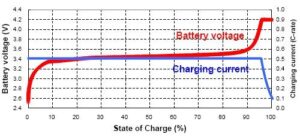Looking for a simple answer to the question “What is an Ah battery?” Well, an Ah battery, or Ampere-hour battery, is a unit of measurement used to determine the capacity of a battery. It indicates the amount of charge that a battery can deliver in one hour. In other words, it’s a way to measure how long a battery will last when powering a device. Curious to learn more about this fascinating topic? Join me as we delve deeper into the world of Ah batteries and uncover their inner workings. So, what is an Ah battery exactly? Let’s find out together!
What is an Ah Battery?
An Ah battery, also known as an ampere-hour battery, is a common type of rechargeable battery used in a wide range of electronic devices and applications. Ah stands for ampere-hour, which is a unit of electrical charge. This type of battery is designed to deliver a specific amount of electrical charge over a certain period of time.
Understanding Ampere-Hour (Ah)
To comprehend what an Ah battery is, it is essential to understand the concept of ampere-hour (Ah). Ampere-hour is a unit used to measure the capacity or energy storage capability of a battery. It represents the amount of charge a battery can deliver in one hour when discharged at a constant rate.
For example, a 1 Ah battery can theoretically deliver a current of 1 ampere for one hour, or 2 amperes for 30 minutes, or 0.5 amperes for 2 hours. The higher the Ah rating, the more charge the battery can store, and consequently, the longer it can power a device.
Types of Ah Batteries
There are various types of Ah batteries available in the market, each with its own unique characteristics and applications. Some of the most common types include:
1. Lead Acid Batteries:
– Lead acid batteries are one of the oldest and most widely used types of Ah batteries.
– They are commonly found in vehicles, uninterruptible power supplies (UPS), and solar power systems.
– Lead acid batteries have a relatively low energy density but provide high current output.
2. Lithium-Ion (Li-ion) Batteries:
– Li-ion batteries have gained popularity due to their high energy density, lightweight, and long cycle life.
– They are commonly used in smartphones, laptops, electric vehicles, and many other portable electronic devices.
– Li-ion batteries offer a good balance between energy storage, weight, and reliability.
3. Nickel-Metal Hydride (Ni-MH) Batteries:
– Ni-MH batteries are often used as a replacement for older nickel-cadmium (Ni-Cd) batteries.
– They are commonly found in digital cameras, power tools, and hybrid electric vehicles.
– Ni-MH batteries have a higher energy density than lead acid batteries but lower than Li-ion batteries.
4. Nickel-Cadmium (Ni-Cd) Batteries:
– Ni-Cd batteries were extensively used in the past but are gradually being replaced by newer technologies.
– They are still found in certain applications such as emergency lighting, two-way radios, and medical devices.
– Ni-Cd batteries are known for their robustness and ability to handle high discharge currents.
Factors Affecting Ah Battery Performance
The performance of an Ah battery can be influenced by several factors, including:
1. Temperature:
– Extreme temperatures can significantly impact the performance and lifespan of Ah batteries.
– High temperatures can cause accelerated self-discharge and reduce overall capacity.
– On the other hand, very low temperatures can decrease the battery’s ability to deliver charge efficiently.
2. Discharge Rate:
– The Ah rating of a battery is typically specified for a specific discharge rate.
– Higher discharge rates can decrease the overall capacity of the battery.
– It is crucial to consider the discharge rate requirements of the device when selecting an Ah battery.
3. Depth of Discharge (DOD):
– The depth of discharge refers to the percentage of the battery’s capacity that has been utilized.
– Deep discharge cycles (high DOD) can have a negative impact on the battery’s lifespan.
– Shallower discharge cycles (low DOD) usually result in longer battery life.
Advantages and Disadvantages of Ah Batteries
Like any other battery technology, Ah batteries have their own set of advantages and disadvantages:
Advantages:
– Rechargeable: Ah batteries can be recharged multiple times, making them cost-effective and environmentally friendly.
– Versatility: They are available in various sizes and shapes to suit different applications and devices.
– Portable Power: Ah batteries provide a convenient source of portable power, allowing devices to operate without a direct power source.
– High Energy Density: Certain types of Ah batteries, such as Li-ion, offer high energy density, making them ideal for compact devices.
Disadvantages:
– Self-Discharge: Ah batteries can self-discharge over time, even when not in use, resulting in a loss of stored energy.
– Lifespan: The number of charge-discharge cycles a battery can endure before its capacity diminishes varies among different types.
– Environmental Impact: Improper disposal of batteries can lead to environmental pollution due to the presence of toxic substances.
Choosing the Right Ah Battery
When selecting an Ah battery for a specific application, there are several factors to consider:
1. Battery Capacity: Determine the required battery capacity based on the device’s power consumption and desired operating time.
2. Voltage: Ensure the battery voltage matches the device’s voltage requirements.
3. Size and Shape: Consider the physical dimensions and shape of the battery to ensure compatibility with the device.
4. Usability: Evaluate the intended usage pattern, such as frequent recharging or occasional use, to select a suitable battery chemistry.
5. Environmental Factors: Consider temperature extremes and any special environmental conditions the battery will be exposed to.
Caring for Ah Batteries
To maximize the lifespan and performance of Ah batteries, here are some care tips:
1. Avoid Extreme Temperatures: Store and operate batteries within the recommended temperature range.
2. Proper Charging: Follow the manufacturer’s guidelines for charging to prevent overcharging or undercharging.
3. Avoid Deep Discharge: Minimize prolonged deep discharge cycles to extend the battery’s lifespan.
4. Regular Use: Utilize the battery and recharge it periodically, even if it is not in frequent use.
5. Safe Storage: Store batteries in a cool, dry place away from direct sunlight and potentially hazardous materials.
By understanding what an Ah battery is and considering various factors, you can make informed decisions when selecting, using, and caring for these rechargeable power sources. Whether you need a battery for your smartphone, car, or any other electronic device, choosing the right Ah battery will ensure optimal performance and longevity.
Frequently Asked Questions
What is an AH battery?
An AH battery, also known as an ampere-hour battery, is a measure of a battery’s capacity to deliver electrical energy over time. It represents the amount of continuous current a battery can supply for one hour. One ampere-hour (AH) refers to the capability of the battery to provide one ampere of current for one hour or two amperes for half an hour, and so on.
What is the significance of AH in batteries?
The AH rating of a battery is crucial as it indicates its capacity to store and deliver electric charge. It helps determine how long the battery can power a particular device or system before needing to be recharged or replaced. Higher AH ratings generally imply a longer runtime for the device or system being powered.
How does the AH rating affect battery life?
The AH rating affects the battery life in terms of how long it can provide power before requiring a recharge. A battery with a higher AH rating typically has a longer lifespan since it is designed to deliver current for a more extended period. However, it’s essential to consider the power requirements of the devices or systems being used to ensure the battery’s AH rating matches the needs.
Can I replace a battery with a different AH rating?
It is generally recommended to replace a battery with the same or similar AH rating as the original one. Using a battery with a significantly lower AH rating may lead to shorter runtimes and more frequent recharging. On the other hand, using a battery with a higher AH rating may not necessarily provide any additional benefits unless the device or system being powered requires the increased capacity.
Do all batteries have an AH rating?
No, not all batteries have an AH rating. AH ratings are commonly used for lead-acid batteries, which are often found in vehicles, backup power systems, and renewable energy installations. Other types of batteries, such as lithium-ion or nickel-metal hydride batteries, may use different rating systems or specifications to indicate their capacity and performance.
Are there any limitations to the AH rating?
While the AH rating is a useful measure of a battery’s capacity, it does not account for factors such as battery age, temperature, or the discharge rate. These factors can impact the actual runtime and performance of the battery. It’s important to consider these variables along with the AH rating when evaluating the suitability of a battery for a specific application.
Final Thoughts
An Ah battery, also known as Ampere-hour battery, is a unit of measurement used to determine the capacity of a battery to store electrical energy. It indicates the amount of current a battery can supply over a specific period of time. In simpler terms, Ah battery tells us how long a battery can power a device before needing to be recharged. By understanding the Ah rating of a battery, users can better estimate its performance and suitability for their devices. So, next time you come across the term “Ah battery,” you’ll know exactly what it means and its significance in determining your device’s power supply.



